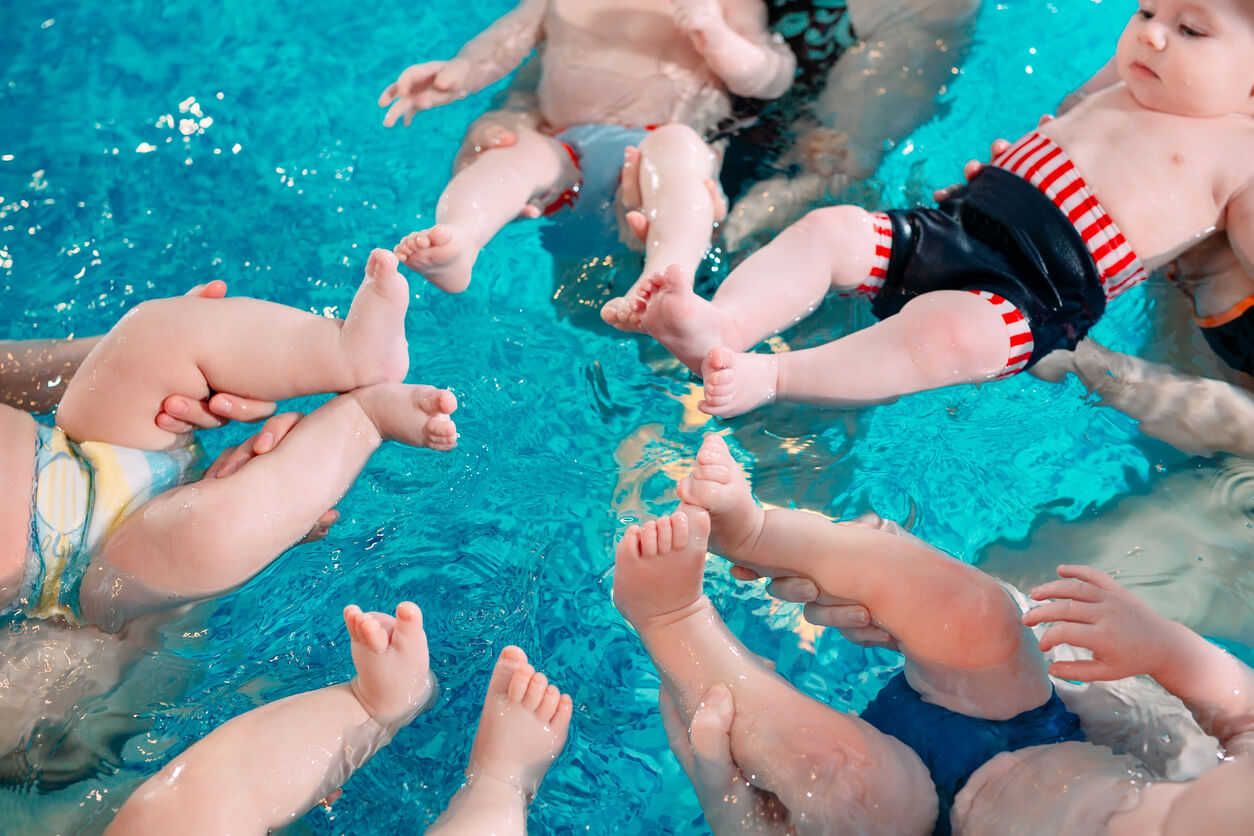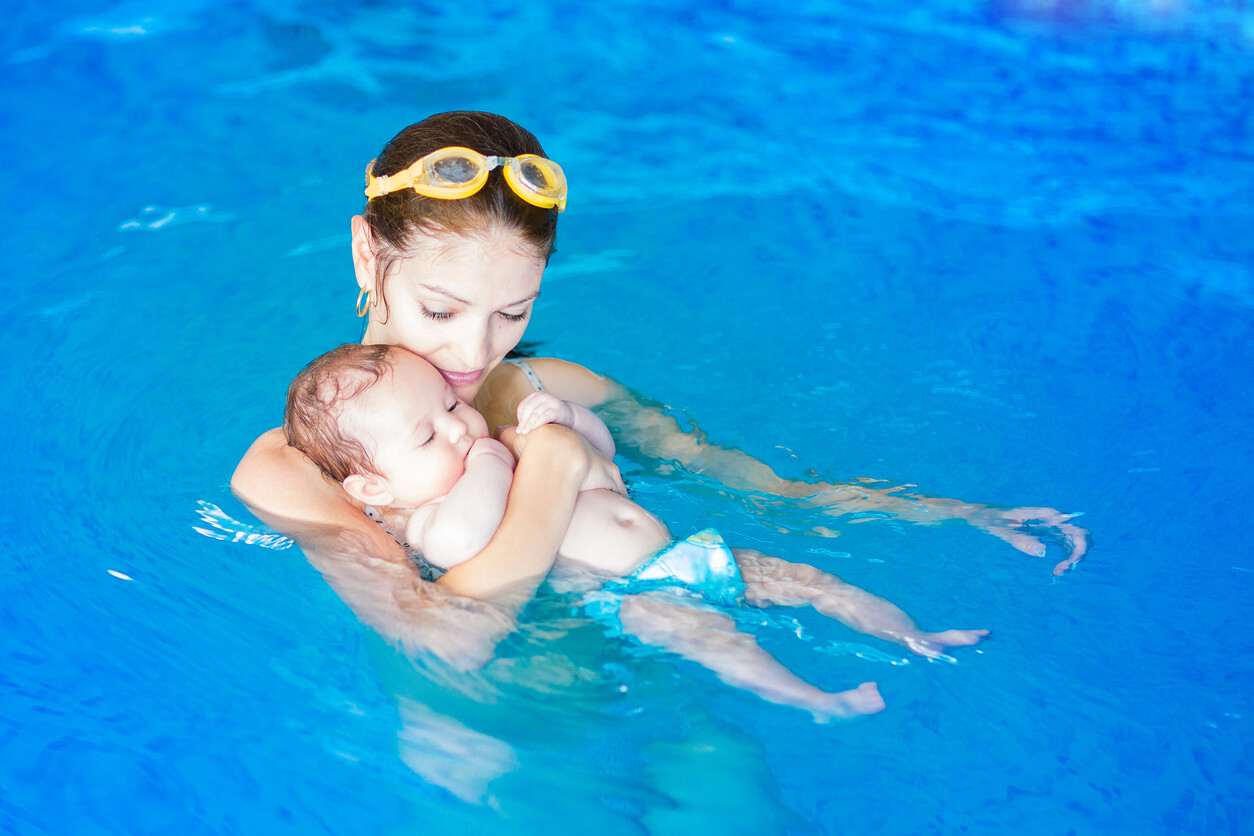7 Swimming Exercises for Your Baby


Written and verified by degree in physical education and sports Andrés Felipe Cardona Lenis
Swimming is perhaps one of the best sporting alternatives, if not the best of all. Through swimming exercises for your baby, it’s possible to stimulate their development and achieve a myriad of health benefits.
Have you considered swimming together? If the answer is yes, we’ll teach you a series of exercises to implement in the water with your little one.
Remember that, besides being a sport, swimming is a great opportunity to promote healthy habits in your children. In addition, it stands out as a very entertaining activity for any age.
Swimming exercises for your baby
Besides programming the activity at the pool, make sure that your baby finds the fun in what they’re doing. The main objective is to make swimming fun for them.
Based on the above, you and the swimming instructor will have to encourage the child to become familiar with the water and, consequently, be enthusiastic about the activities that follow.
Here are some fun and useful swimming exercises to do with little ones.
1. Feet flapping

What you should know about: 11 Things You Should Take to the Pool for Your Baby
Feet flapping is one of the first movements babies make when they get into the pool. It’s very important, as the movement promotes their confidence in the environment and is a good way to become familiar with it.
It’s usually performed at the edge of the pool. The baby sits there and only their legs are introduced so that their feet begin to feel the water.
It’s also possible to carry it out on shallow surfaces, such as the wading pool or some wide steps.
2. Walk around
Among the swimming exercises for your baby, walking around the pool is fundamental. Even though your child is young, it’s easy to determine what catches their attention and what doesn’t.
For this reason, walk hand in hand with your child around the pool and focus on their reaction. If they want to get in the water or experiment in it, they’ll probably wave their hands at you and start smiling.
3. Collect toys
Once they’ve gained confidence with the pool and show an intention to swim, you can turn the experience into a more enjoyable practice. To do this, try to distribute toys in a considerable portion of the water.
Introduce them to the water and encourage them to collect the objects and carry them from one side of the pool to the other. It’s important for the baby to have floaties and the constant presence of a responsible adult.
4. Getting their face wet
Although your baby has spent most of its life in an aquatic environment (the mother’s womb) and the experience with the pool isn’t traumatic, it’s still important to look for alternatives to make it even more pleasant.
Getting their face wet can help with this purpose. You shouldn’t take them by surprise; rather, wet them slowly, so that they don’t get scared. Get a glass or a container, fill it with water, and let it fall from the head or forehead.
5. Swimming in the pool
Little by little, swimming for your baby will take shape. A clear example will be the walks inside the pool. When your baby allows you to move them in the water, you’ll be able to determine if they really like the activity.
There are several ways to do this type of walk, but we’ll show you the traditional way to carry your little one. You should take your baby by the armpits, lay them face up in the water, and move him across the surface. Then, do the same exercise face down.
The important thing is to do it in a way that allows them to gain confidence.

6. Jumps and dives
Jumps and dives require a higher level of self-confidence. However, they’re exercises that can be done with proper professional supervision.
Let your baby stand at the edge of the pool and encourage them to jump forward. Once inside, they’ll go underwater from the momentum of the fall.
For the first few jumps with submersion, they’ll need your help to get out of the water. But gradually, they’ll begin to do it on their own.
7. Initiate propulsion
Dorsal and ventral movements are performed to stimulate the movement of hands and feet. The wall is used to achieve the plantar support reflex and toys are used to encourage manipulation.
Spontaneous movements that propel your child occur through their underwater reflex, submersion, or diving. Indeed, when submerging the baby in a ventral position (tummy down) you’ll see that it straightens the cervical spine. In addition, it closes its glottis as a reflex to protect the airway and moves its four limbs to propel itself.
Discover: Swim Diapers: A Guide for Parents
Aspects to take into account regarding swimming exercises for babies
Exercises, games, and fun activities are plentiful. However, there are a number of things to consider before your baby participates in swimming:
- You should see your pediatrician for approval of the activity and for the child’s physical fitness. Some doctors recommend activity from 3 months of age, others before or after. Opinions on the subject vary, so it’s essential that you discuss it with a professional.
- The duration of each session should average 40 minutes.
- Regarding the accompaniment, it’s advisable for one of the parents to go with the baby. And if possible, both.
- The baby shouldn’t be alone at any time while in or near the pool.
Swimming is perhaps one of the best sporting alternatives, if not the best of all. Through swimming exercises for your baby, it’s possible to stimulate their development and achieve a myriad of health benefits.
Have you considered swimming together? If the answer is yes, we’ll teach you a series of exercises to implement in the water with your little one.
Remember that, besides being a sport, swimming is a great opportunity to promote healthy habits in your children. In addition, it stands out as a very entertaining activity for any age.
Swimming exercises for your baby
Besides programming the activity at the pool, make sure that your baby finds the fun in what they’re doing. The main objective is to make swimming fun for them.
Based on the above, you and the swimming instructor will have to encourage the child to become familiar with the water and, consequently, be enthusiastic about the activities that follow.
Here are some fun and useful swimming exercises to do with little ones.
1. Feet flapping

What you should know about: 11 Things You Should Take to the Pool for Your Baby
Feet flapping is one of the first movements babies make when they get into the pool. It’s very important, as the movement promotes their confidence in the environment and is a good way to become familiar with it.
It’s usually performed at the edge of the pool. The baby sits there and only their legs are introduced so that their feet begin to feel the water.
It’s also possible to carry it out on shallow surfaces, such as the wading pool or some wide steps.
2. Walk around
Among the swimming exercises for your baby, walking around the pool is fundamental. Even though your child is young, it’s easy to determine what catches their attention and what doesn’t.
For this reason, walk hand in hand with your child around the pool and focus on their reaction. If they want to get in the water or experiment in it, they’ll probably wave their hands at you and start smiling.
3. Collect toys
Once they’ve gained confidence with the pool and show an intention to swim, you can turn the experience into a more enjoyable practice. To do this, try to distribute toys in a considerable portion of the water.
Introduce them to the water and encourage them to collect the objects and carry them from one side of the pool to the other. It’s important for the baby to have floaties and the constant presence of a responsible adult.
4. Getting their face wet
Although your baby has spent most of its life in an aquatic environment (the mother’s womb) and the experience with the pool isn’t traumatic, it’s still important to look for alternatives to make it even more pleasant.
Getting their face wet can help with this purpose. You shouldn’t take them by surprise; rather, wet them slowly, so that they don’t get scared. Get a glass or a container, fill it with water, and let it fall from the head or forehead.
5. Swimming in the pool
Little by little, swimming for your baby will take shape. A clear example will be the walks inside the pool. When your baby allows you to move them in the water, you’ll be able to determine if they really like the activity.
There are several ways to do this type of walk, but we’ll show you the traditional way to carry your little one. You should take your baby by the armpits, lay them face up in the water, and move him across the surface. Then, do the same exercise face down.
The important thing is to do it in a way that allows them to gain confidence.

6. Jumps and dives
Jumps and dives require a higher level of self-confidence. However, they’re exercises that can be done with proper professional supervision.
Let your baby stand at the edge of the pool and encourage them to jump forward. Once inside, they’ll go underwater from the momentum of the fall.
For the first few jumps with submersion, they’ll need your help to get out of the water. But gradually, they’ll begin to do it on their own.
7. Initiate propulsion
Dorsal and ventral movements are performed to stimulate the movement of hands and feet. The wall is used to achieve the plantar support reflex and toys are used to encourage manipulation.
Spontaneous movements that propel your child occur through their underwater reflex, submersion, or diving. Indeed, when submerging the baby in a ventral position (tummy down) you’ll see that it straightens the cervical spine. In addition, it closes its glottis as a reflex to protect the airway and moves its four limbs to propel itself.
Discover: Swim Diapers: A Guide for Parents
Aspects to take into account regarding swimming exercises for babies
Exercises, games, and fun activities are plentiful. However, there are a number of things to consider before your baby participates in swimming:
- You should see your pediatrician for approval of the activity and for the child’s physical fitness. Some doctors recommend activity from 3 months of age, others before or after. Opinions on the subject vary, so it’s essential that you discuss it with a professional.
- The duration of each session should average 40 minutes.
- Regarding the accompaniment, it’s advisable for one of the parents to go with the baby. And if possible, both.
- The baby shouldn’t be alone at any time while in or near the pool.
All cited sources were thoroughly reviewed by our team to ensure their quality, reliability, currency, and validity. The bibliography of this article was considered reliable and of academic or scientific accuracy.
- Angulo P., P. (2022). Metodología de la enseñanza de la natación en niños. [Trabajo de Fin de Titulación, Universidad Europea]. https://titula.universidadeuropea.com/handle/20.500.12880/1729
- García, J. L., López, A. M. S., García, L. B., de Cabo, L. F., Benítez, I. V., & Cordero, M. J. A. (2017). Actividad física en el agua para mejorar la psicomotricidad de los bebés sanos. Protocolo del estudio Babyswimming. Journal of Negative and No Positive Results: JONNPR, 2(5), 186-193. https://dialnet.unirioja.es/servlet/articulo?codigo=5972916
- Johnson, M. B., Boriack, E. D., McConnell, C. M., & Lawson, K. A. (2022). Impact of caregiver swimming capability on perceptions of swimming pool supervision of toddlers. Injury epidemiology, 9(1), 1-8. https://www.ncbi.nlm.nih.gov/pmc/articles/PMC9768878/
- Latorre García, J., Sánchez-López, A. M., Baena García, L., Noack Segovia, J. P., & Aguilar-Cordero, M. J. (2016). Influencia de la actividad física acuática sobre el neurodesarrollo de los bebés: revisión sistemática. Nutrición Hospitalaria, 33, 10-17. https://medes.com/publication/119144
- Leo, I., Leone, S., Dicataldo, R., Vivenzio, C., Cavallin, N., Taglioni, C., & Roch, M. (2022). A Non-Randomized Pilot Study on the Benefits of Baby Swimming on Motor Development. International journal of environmental research and public health, 19(15), 9262. https://www.mdpi.com/1660-4601/19/15/9262
- Moreno-Murcia, J. A., Albarracín, A., & De Paula, L. (2022). Aportes pedagógicos acuáticos. Buenos Aires: Sb Editorial. https://www.asociacionaidea.com/nuevo-libro-publicado-aportes-pedagogicos-acuaticos/
- Sanz, M. (2017). El bebé y el niño pequeño en el agua: Aplicación de los principios de Emmi Pikler en pedagogía acuática para la primera infancia. Revista de investigación en actividades acuáticas, 1(2), 61-66. https://revistas.innovacionumh.es/index.php/investigacionactividadesacuatica/article/view/394
This text is provided for informational purposes only and does not replace consultation with a professional. If in doubt, consult your specialist.








